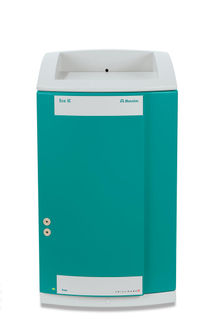To use all functions of this page, please activate cookies in your browser.
my.chemeurope.com
With an accout for my.chemeurope.com you can always see everything at a glance – and you can configure your own website and individual newsletter.
- My watch list
- My saved searches
- My saved topics
- My newsletter
Heisenberg model (quantum)The Heisenberg model is a statistical mechanical model used in the study of critical points and phase transitions of magnetic systems, in which the spin of the magnetic systems are treated quantum mechanically. In the prototypical Ising model, defined on a d-dimensional lattice, at each lattice site, a spin Product highlightFor quantum mechanical reasons (see exchange interaction), the dominant coupling between two dipoles may cause nearest-neighbors to have lowest energy when they are aligned. Under this assumption (so that magnetic interactions only occur between adjacent dipoles) the Hamiltonian can be written in the form for a 1-dimensional model consisting of N dipoles, subject to the periodic boundary condition σN + 1 = σ1. The Heisenberg model is a more realistic model in that it treats the spins quantum-mechanically, by replacing the spin by a quantum operator (Pauli spin-1/2 matrices at spin 1/2), and the coupling constants Jx,Jy, and Jz. As such in 1-dimension, the Hamiltonian is given by where the h on the right-hand side indicates the external magnetic field, with periodic boundary conditions, and at spin s = 1 / 2, spin matrices given by The Hamiltonian then acts upon the tensor product The physics of the Heisenberg model strongly depends on the sign of the coupling constant J and the dimension of the space. For positive J the ground state is always ferromagnetic. At negative J the ground state is antiferromagnetic in two and three dimensions. In one dimension the nature of correlations in the antiferromagnetic Heisenberg model depends on the spin of the magnetic dipoles. If the spin is integer then only short range order is present. A system of half-integer spins exhibits quasi-long range order.
See alsoReferences
Categories: Statistical mechanics | Lattice models |
| This article is licensed under the GNU Free Documentation License. It uses material from the Wikipedia article "Heisenberg_model_(quantum)". A list of authors is available in Wikipedia. |


 represents a microscopic magnetic dipole to which the magnetic moment is either up or down.
represents a microscopic magnetic dipole to which the magnetic moment is either up or down.








 , of dimension
, of dimension  . The spin 1/2 Heisenberg model in one dimension may be solved exactly using the
. The spin 1/2 Heisenberg model in one dimension may be solved exactly using the 

